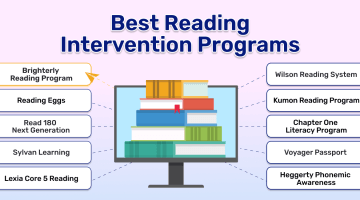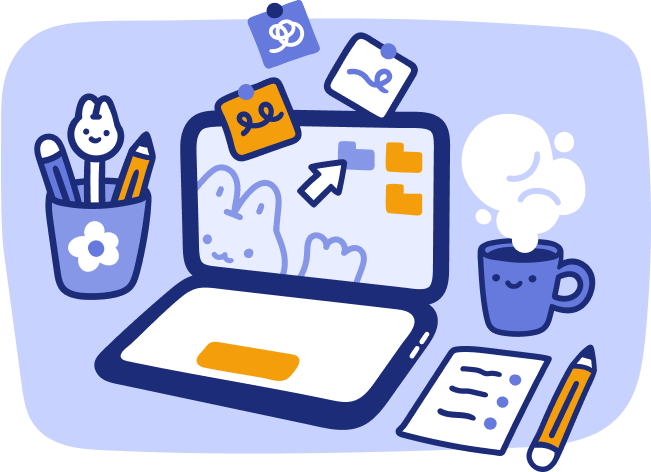Types of Reading Skills for Academic Success at Every Level
reviewed by Franz Jerby Delos Santos
Updated on October 23, 2025
Understanding types of reading skills is key for parents who’d like to help their child all the way through school. Is your child a first-grader focusing on decoding and recognizing sight words? Or maybe they’re middle schoolers who read between the lines? This post will help you spot which skills your child needs to learn at every stage.
Key points
- The main types of reading skills fall into foundational literacy skills (phonics, decoding, fluency, vocabulary) and strategic reading techniques (skimming, scanning, intensive, and extensive reading).
- As children grow, reading evolves from learning to read (grades 1-3) to reading to learn (grades 4-6) and finally to analyzing and evaluating texts (grades 7-9).
- Core comprehension skills – inference, main idea recognition, vocabulary in context, and questioning – enable children to interpret and connect meaningfully with texts.
- Brighterly offers grade-specific diagnostic reading tests for grades 1–9, showing exactly what your child is great at and what needs a little work across all stages of reading development.
What are the types of reading skills?
- Foundational literacy skills – phonics, decoding, fluency, and vocabulary – develop basic reading ability.
- Strategic reading approaches – skimming, scanning, intensive reading, and extensive reading – guide how children engage with various texts.
The types of reading skills entail different abilities and strategies for understanding written text. As children grow, good reading skills evolve from basic decoding to critical comprehension.
1st – 3rd grade reading skills
- Phonological and phonemic awareness – identifying and manipulating individual sounds in words (e.g., changing C in ‘cat’ to B for ‘bat’)
- Through phonics, they learn to connect letters to sounds and blend them to read new words
- Early fluency emerges as children move from slow, word-by-word reading to smoother phrasing
- They also build basic comprehension by answering simple who, what, and where questions and retelling stories
- Expanding vocabulary, especially high-frequency sight words.
Many children need extra guidance at this early stage. That’s why platforms like Brighterly offer personalized online reading programs with fun activities and professional tutors.
You can find out your child’s strong suits and areas needing support through free diagnostic assessments, developed by Brighterly math and reading platform specifically for the particular grades:
| 1st grade reading test | 2nd grade reading test | 3rd grade reading test |
4th – 6th grade reading skills
- Developing deeper comprehension by identifying main ideas and supporting details in complex, multi-paragraph texts
- Inferencing skills help them read between the lines and understand the things the author hints at, yet doesn’t say outright
- Vocabulary expands through context clues – using surrounding sentences to decode unfamiliar words independently
- Recognizing different informational structures (e.g., cause-and-effect, comparison/contrast, and sequence)
- Advanced fluency means reading silently at an efficient pace while maintaining strong comprehension
- Summarizing – boiling big chunks of text down to the main idea.
Note: At this level, reading skills become more advanced, and many children start struggling with comprehension or focus. Brighterly’s reading lessons are meant to support this transition through interactive exercises and real-time tutor feedback.
Reading tests by Brighterly are grade-classified for more accurate, reliable results. It’s the best choice since they’re free and without relying on subjective school reports:
| 4th grade reading test | 5th grade reading test | 6th grade reading test |
7th – 9th grade reading skills
- Critical reading abilities entail analyzing an author’s purpose, perspective, and potential biases
- Synthesis skills enable students to combine ideas from multiple sources and, thus, form original conclusions
- Learning to support interpretations with textual evidence, using direct quotes and specific references to justify their claims
- Literary analysis deepens as they examine figures of speech, tone, symbolism, and rhetorical techniques that authors employ
- Abstract reasoning allows them to make complex predictions and recognize nuanced themes.
To track growth while developing reading skills, let your child pass Brighterly’s diagnostic reading checks (developed by the best reading tutors) and get a clear breakdown of the results. BTW, Lexile levels can help you interpret them even more accurately.
| 7th grade reading test | 8th grade reading test | 9th grade reading test |
4 basic types of reading skills
Skimming
The first type of reading skills is skimming. It’s a quick reading method to get the gist of a text without focusing on details. Children look for keywords, headings, and highlighted sentences to quickly understand the general theme.
Skimming is used when, say, previewing a book, article, or passage, as well as processing large amounts of information. That’s when children decide whether or not something is worth a deeper read. So, it’s prioritizing speed and general understanding over complete comprehension.
Scanning
The list of reading skills goes on with scanning, which is used to quickly hunt down a specific fact within a text. Holding the target information in mind, children ignore all other details until finding the specific data point.
For example, when searching for a date in a history book, a definition in a glossary, or a fact in an article, scanning is best, since you don’t need to understand the entire passage. Instead, you first get the overall meaning (via skimming) and then extract the required information fast.
Intensive reading
Unlike the two types of reading skills covered above, intensive reading is a slow and detailed strategy. Focusing on total comprehension, it aims at complete mastery of the content. That entails looking closely at every word and sentence, vocabulary word, and supporting detail.

In academic or classroom settings, intensive reading helps build accurate language skills, deepen understanding of complex material, and improve children’s ability to recall and synthesize specific information for retention.
Extensive reading
The basic list of 4 types of reading skills won’t be complete without extensive reading, which gets kids reading lots of fun, easy stuff theyactuallylike.
It strives for general understanding, pleasure, and building reading fluency. Here, we speak of books, stories, or articles that match children’s interests and proficiency level. Thanks to maintaining a faster pace during extensive reading, it’s much easier to develop a better sense of language flow, grow their word power, and build a lifelong love of reading.
Other types of reading skills
Note: Up to this point, we’ve covered the fundamental techniques for decoding words and locating information – the essential groundwork for getting through a text. Now, it’s time to focus on active and deep comprehension of its meaning, structure, and intent – skills needed for reading comprehension in academic success and lifelong learning.
Type of reading skills #1: Critical reading
What is? An active, reflective process where, instead of simply accepting the information in a text, children question and judge it.
Purpose: Not just to understand what is said in a text, but to question how and why it’s said. The goal is to assess the quality, validity, trustworthiness, and, therefore, help children form informed opinions. They achieve it by making judgments about the author’s credentials, questioning the evidence provided, detecting logical flaws, and identifying any potential bias or unstated assumptions.
For example, critical reading is used when engaging with persuasive texts, opinion pieces, advertisements, etc.
Type of reading skills #2: Analytical reading
What is? Breaking down a text into its components – structure, themes, language, etc. – to understand how meaning is constructed.
Purpose: To see not just what the text says, but to understand the creation of senses. Children uncover the author’s intent by identifying the main thesis, outlining the major parts and how they work together, and examining patterns of reasoning.
For example, studying literature, essays, and academic papers is impossible without the skill of analytical reading.
Type of reading skills #3: Inferential reading
What is? Among types of comprehension skills, it entails ‘reading between the lines.’
Purpose: To pick up on what’s not said directly, predict outcomes, and understand the implied motivations, themes, or messages. Children make it by connecting facts, emotions, and hints. They also combine clues within the text with their own prior knowledge and logical reasoning.
For example, if a story says, She grabbed her umbrella and shivered as she stepped outside, children infer it’s cold and rainy without being told directly.
Or, say, a passage states: Maria checked her phone for the fifth time in ten minutes, then shoved it deep into her bag with a sigh. The text never says Maria is waiting for an important message or feeling anxious. However, children infer these emotions from her repetitive behavior and physical gestures.
Type of reading skills #4: Evaluative reading
What is? The ability to judge a text’s quality, relevance, and personal impact. With it, children assess whether or not the information is useful, convincing, or emotionally resonant.
Purpose: To finish off on the types of reading skills and their purpose, in evaluative reading, children relate what they read to their own lives, values, or prior knowledge. They link the text’s ideas to real-life situations. They also compare its quality to other similar works, and, therefore, form a personal opinion.
For example, evaluative reading is applied when selecting sources for research, choosing books to read, or determining their relevance to children’s situations. They usually ask: Does this information solve my problem? or Would I recommend this to others?
Note: You’ll find even more practical comprehension-building methods once you start helping your child to improve their reading skills. Given the comprehension skills meaning, you’ll dive deeper into mental and linguistic strategies used to make sense of text.
List of reading comprehension skills
#1 Reading between the lines: Making inferences
Making inferences means understanding what the author implies, yet does not state directly. When building reading skills, this one encourages thinking critically and reading beyond surface details. It allows one to connect two or more pieces of information to arrive at a third, implicit conclusion.
This skill develops gradually. It starts with simple cause-and-effect relationships in early grades and, further in later years, advances to understanding complex motivations, themes, and symbolism. Teaching inference helps children become more active and engaged readers who can interpret emotions, motivations, and outcomes that aren’t explicitly mentioned.

As parents, you can support this skill by asking ‘why do you think’ questions during shared reading, thus getting kids to back up their ideas and interpretations with evidence from the text. Reading worksheets from Brighterly is yet another helpful tool for parents.
#2 Finding the ‘big picture’: Main ideas and summarizing
This skill involves distinguishing between essential and supporting details to grasp what the author wants to communicate. When children summarize, they restate the key points in their own words and, therefore, show they truly comprehend the text.
This skill proves invaluable across all subjects, from retelling story plots to extracting key points from science articles. However, young readers often struggle to separate major themes from interesting yet minor details. So, this process does require teaching and will ultimately result in strengthened comprehension and memory.
As parents, you can help by asking children to explain ‘what was this mainly about?’ after reading. Don’t forget to gradually help them give short, to-the-point answers.
#3 Unlocking words: Vocabulary in context
Understanding vocabulary in context is just as important as other types of reading comprehension skills. It means using clues within a sentence or paragraph to figure out the meaning of unfamiliar words. Instead of relying on a dictionary, children learn to interpret new words through surrounding hints, tone, and examples.
Striving for independent reading and improving vocabulary, as children encounter new words across different texts, they use context clues (i.e., synonyms, antonyms, definitions, and examples) to help them expand their vocabulary naturally and read with greater confidence. This skill also includes understanding how prefixes, suffixes, and root words provide meaning hints. Besides, as children advance, they learn that words can have multiple meanings depending on context, requiring flexible thinking.
As parents, you can encourage children to make educated guesses about word meanings before confirming them. It teaches problem-solving and reduces dictionary dependence.
#4 Engaging with the text: Questioning and connections
To clarify meaning and stay curious, children ask questions before, during, and after reading, like Why did the character act this way? or What might happen next?
Making connections between the text and
- personal experiences (text-to-self),
- other stories (text-to-text), or
- real-world events (text-to-world)
Helps children relate emotionally and intellectually to what they read.
Therefore, among different types of reading skills and strategies, this one turns reading into a thoughtful dialogue between the reader and the author.
As parents, you can model these behaviors by thinking aloud while reading together. You can demonstrate how good readers constantly interact mentally with texts instead of simply absorbing words.
What are the major reading skills?
- Word recognition allows children to decode text accurately.
- Fluency enables them to read smoothly and efficiently.
- Comprehension transforms those decoded words into meaningful understanding.
This ‘Big Three’ compose the ability to read. Without any one of them, the reading process breaks down. What are the types of reading skills to access the text through any method? The answer is ‘big three’
However, moving from basic access to the ability to comprehend, the major reading skills are those sophisticated cognitive strategies. We’re talking the ability to make inferences, find a main idea, or engage in critical analysis. This is what governs how the text is processed.
Conclusion
Now that we’ve looked at all the different types of readings skills by grade level, comprehension strategies, and advanced techniques, hopefully, you’re no longer wondering why are reading skills important so much?
If your kids experience difficulties with studying, first check their background knowledge with free tests. Then, get some practice in writing and listening skills. It might help strengthen comprehension, improve focus, and build connections between spoken and written language.
Or, you may always resort to Brighterly. Book free reading lesson and watch your child fall in love with reading!

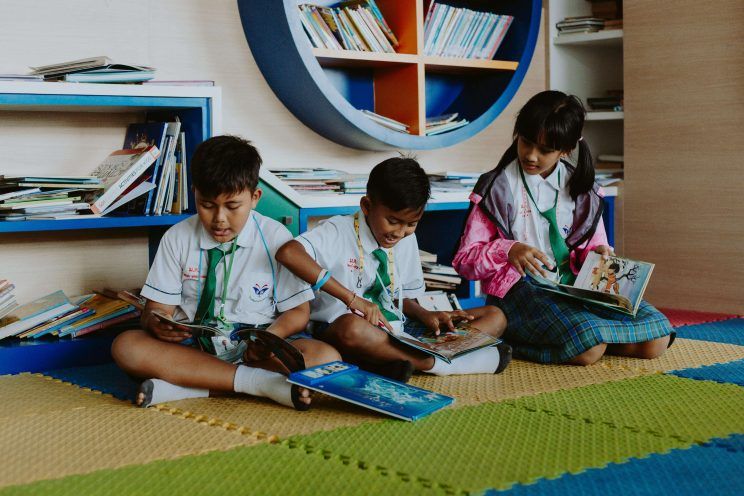
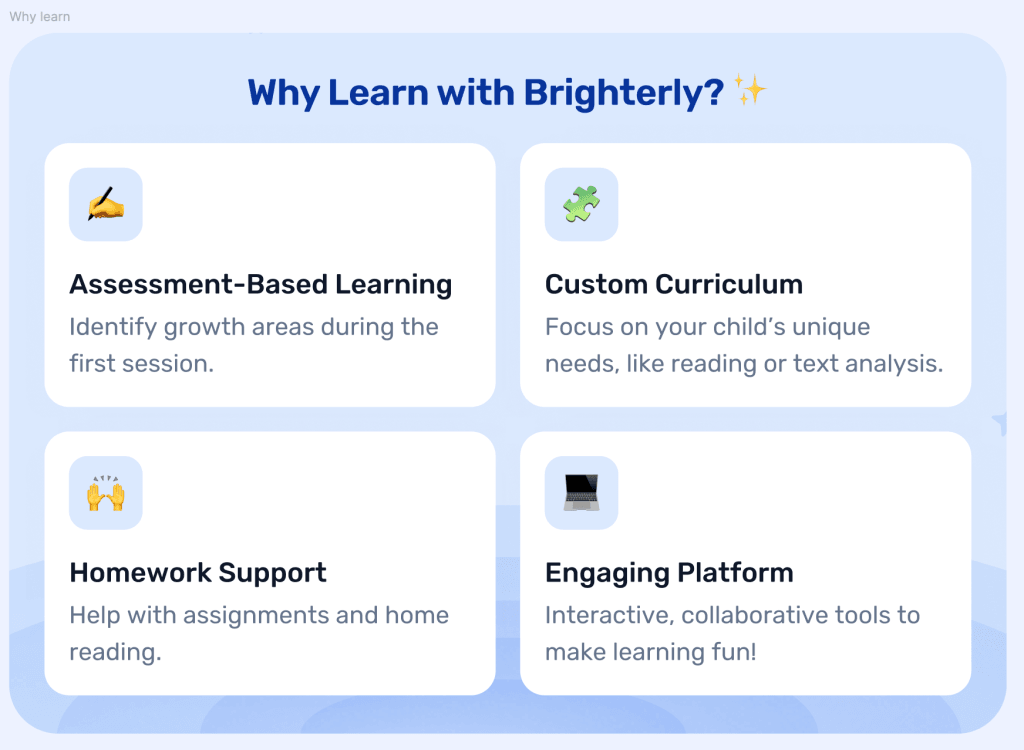
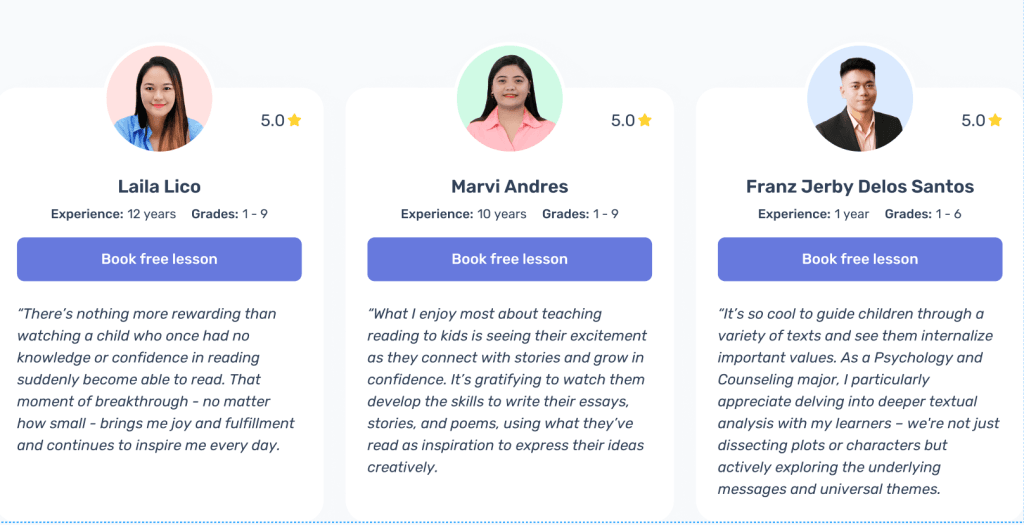
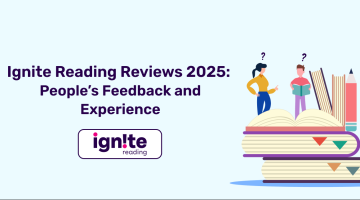



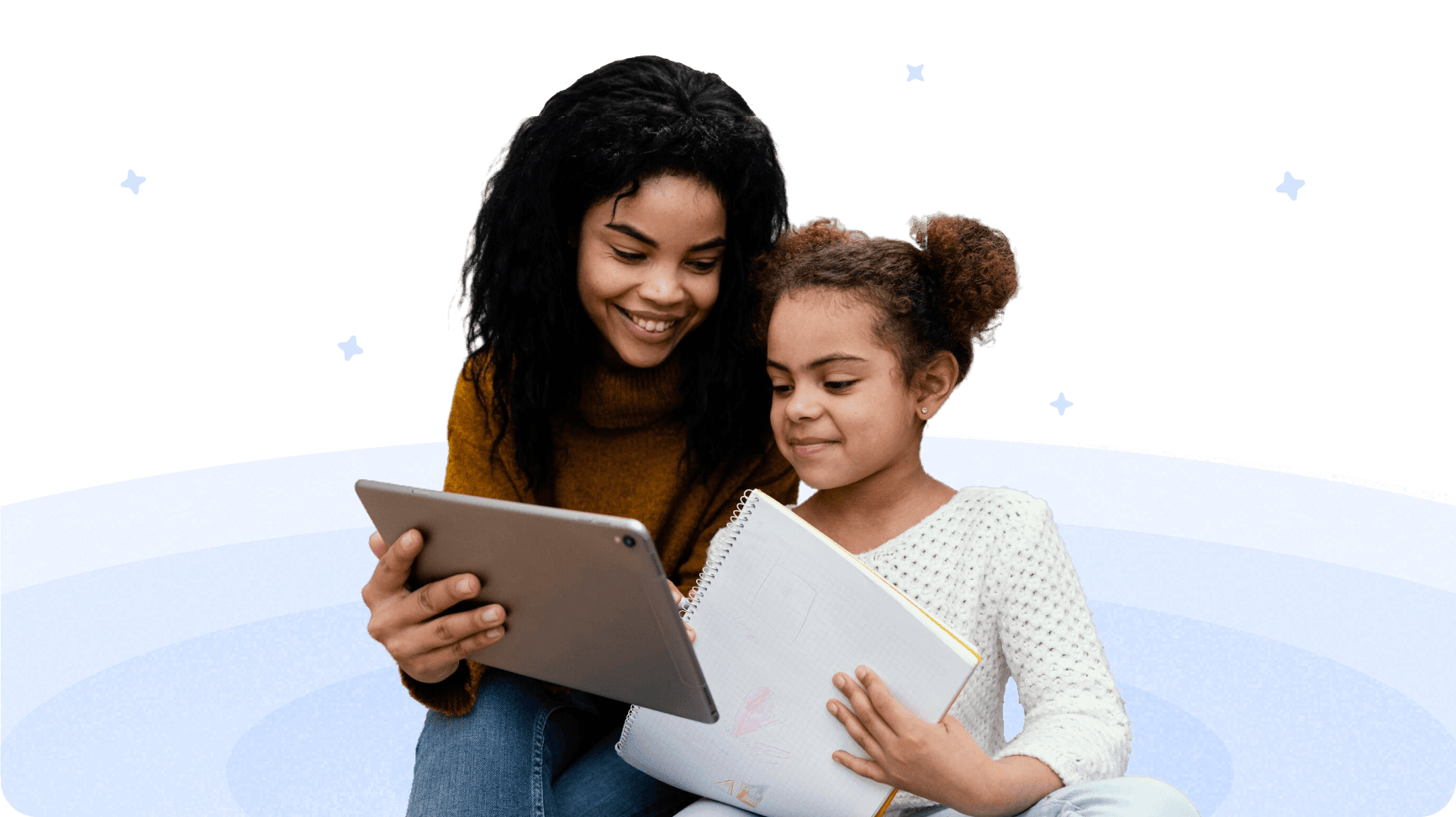

![10 Best LMS Platforms for Online Education [2025]](https://brighterly-stage.xyz/wp-content/uploads/2025/08/Best-LMS-Platforms-360x200.png)
